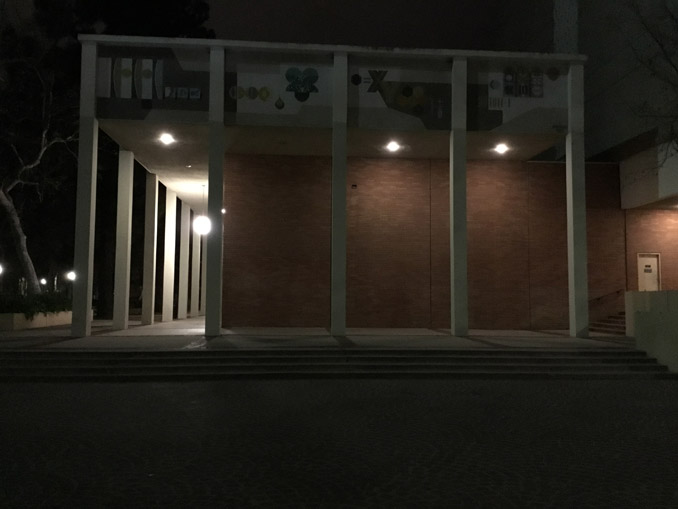The Apple iPad Pro Review
by Ryan Smith, Joshua Ho & Brandon Chester on January 22, 2016 8:10 AM ESTCamera
While it’s pretty much a universally terrible idea to use a tablet as your primary camera, for something like video chat or in an emergency it’s better to have one than not. In the case of the iPad Pro, the camera is essentially identical to what we saw with the iPad Air 2, which is to say an 8MP 1.1 micron 1/4” sensor, with an F/2.4 aperture and 3.3mm focal length, which translates to a 35mm equivalent focal length of 31mm. There’s no PDAF or anything fancy going on here, so it’s pretty much a guarantee that the camera is the exact same module that we saw with the iPad Air 2. The front facing camera is still a 1.3MP F/2.2 2.65mm focal length module, which leads me to believe that it too is shared with the iPad Air 2. I honestly don’t see any difference between the iPad Air 2 and iPad Pro cameras, so rather than spending time dwelling on those this comparison will be focused upon how it compares to popular smartphones and the tablet competition. As I don’t have a tripod mount that can actually fit the iPad Pro, I’ve elected to forgo some of our standard latency tests to avoid presenting data with confounding variables.
| Daytime Photography Scene 1 |
In our first daytime scene the iPad Pro is actually not that far off from the iPhone 6s. If you look closely it’s obvious that there is less detail to be seen, but it’s honestly quite difficult to see the difference. Relative to the iPhone 6, detail is almost identical. For a camera that should basically be never used for the kinds of photos I’m taking for this review, the camera will work well in a pinch. By comparison the Pixel C is rather disappointing. Even in this ideal condition, detail is visibly worse when compared to the iPad Pro. I’m not sure whether this poor showing is caused by camera shake or AF issues but in general the AF system for the Pixel C had some pretty noticeable issues in general. There are also some obvious problems with color noise despite base ISO, which is shocking.
| Daytime Photography Scene 2 |
In the interest of trying to collect more than one data point for presentation in the review, I tried another scene. Once again, the iPhone 6s shows a minor resolution lead and the iPad Pro is pretty close to the iPhone 6 here. By comparison while there isn’t any obvious weirdness going on the Pixel C clearly has less detail and a noticeable amount of color noise, which is surprising even for a tablet camera. Color noise is one of the most distracting things in any photo, so I’m always concerned when any mobile device has a camera where the JPEG output shows color noise.
| Low Light Photography Scene 1 |
| Low Light Photography Scene 2 |
Moving on to the low light testing, we clearly see the disadvantage that comes with smaller pixel sizes. The iPad Pro is just clearly worse than the iPhone 6 and 6s here. The 6s Plus is the clear winner of this test. While the iPad Pro has dark output, it’s miles better than the Pixel C and Nexus 9, both of which show enormous amounts of color noise. The Tegra X1 and K1 ISP for whatever reason is struggles with doing things like hot pixel compensation in low light, as in the dark areas of the photo there are obvious bright speckles of pixel noise.
| Low Light Photography Scene 3 |
In another low light scene we see the same sort of ordering that was in the previous scene. The iPad Pro is acceptable here, but the iPhone 6, 6s, and 6s Plus are all clearly superior. However, the iPad Pro is clearly superior to the Pixel C and Nexus 9 on the basis of better detail and noise reduction. Unlike most smartphones I don’t really see a huge difference in how well everything freezes motion here, but I suspect this might just be because the entire image for the Pixel C and Nexus 9 is so lacking in detail.
Video
| 1080p30 Video |
Looking at video performance, the iPad Pro noticeably lags behind the iPhone in feature set, which isn't entirely unsurprising given that the camera on any tablet should be strictly reserved as a fallback for when you can’t get to a smartphone or literally anything else. 1080p30 is encoded with H.264 high profile at 17 Mbps, with around 82 Kbps single channel AAC audio. For the most part, quality here is actually comparable to the iPhone 6 and 6s in daytime, with a noticeably tighter crop due to the longer 35mm equivalent focal length. The iPhone 6s Plus is again the obvious winner here though, due to its use of OIS in video. By comparison, the Pixel C shows clearly less detail, and the higher contrast leads to worse detail in areas like the road and in shadows.
| Slow-Motion Video |
In 720p120, the iPad Pro is clearly worse than the iPhone 6s and 6s Plus just by virtue of not supporting 1080p here. That's not exactly surprising, but as a result the quality looks to be roughly comparable to the iPhone 6. Given that both are using H.264 high profile at 30 Mbps it’s not exactly a surprise though. The Pixel C and Nexus 9 are both unable to participate in this test at all as they don’t support slow motion video, which might be an ISP limitation of some sort as we’ve seen Nexus devices on the smartphone side with support for slow motion video.
Overall, camera performance on the iPad Pro is probably as good as it gets for tablets, but it's obviously not competitive with the best smartphones. No one should really be surprised that this is the case though, as tablets are basically cameras of last resort, while smartphones are often primary cameras now.
Misc.
On the WiFi side unfortunately I have reason to doubt the validity of our current testing methodology, especially on iOS. As a result for this review we won’t be running any particular benchmarks for the iPad Pro but I never saw any particular issues with WiFi performance on the iPad Pro, which uses Broadcom’s BCM4355 WiFi/BT combo chipsets.
I also don’t have any particular equipment to really test speaker quality to its full extent, but subjectively the speakers are some of the best I’ve ever experienced on a mobile device in terms of sheer volume and frequency response. The speaker amps are shared with the iPad Air 2, which is Maxim Integrated’s MAX98721 IC. The audio codec/DAC is Cirrus Logic’s CS42L81, which isn’t entirely unsurprising given how most every Apple mobile device seems to use a Cirrus Logic codec of some sort.
I also found a number of interesting design wins, which include TI’s BQ27540 for the battery fuel gauge, and an MCU related to the Orion dock that seems to handle accessories like the Smart Keyboard. This MCU is connected over i2c, with some suggestion that this connector can act as a USB port, but I haven’t been able to figure out much else about this system.















408 Comments
View All Comments
glenn.tx - Saturday, January 23, 2016 - link
I mean't CAN"T be ignored :0MaxIT - Saturday, February 13, 2016 - link
There is absolutely no way I could (or would) use a Surface Pro as my primary laptop (or even tablet)...digiguy - Saturday, January 23, 2016 - link
I don't think anyone is saying that ipad pro is the only game in town. At least not me. As you can see I am a "multi-device" guy. I don't believe in one device for everything. And all my devices and synced via dropbox + onedrive + sugarsync.I have several activities and a lot of what I do is done via a computer. No surface pro/book or other clone could replace my main device, the one I spend most time on and from which I am writing, a 17 inch quad core i7 with 16GB of RAM, 2 SSDs, 1 HHD, lots of ports etc. I am a heavy multi-tasker and 8GB or a dual core are sometimes not enough.
But my quad core stays at home and I also work on the go (teach at university, among other things) and travel, so I have my SP3 for when I work on the go and my 14 inch ultrabook for travelling (better on my lap and on a plane).
So each device has a role and I would never dream of replacing any laptop with the ipad pro... I think very few people buy the ipad pro with this objective. For what I use it for ipad pro beats SP3 on a lot of things (size, sound, weight, touch optimization) and that’s why I bought it.
Constructor - Saturday, January 23, 2016 - link
Yeah, when backward desktop compatibility is the primary thing you need.The whole point of contention her is that some people overgeneralize their own needs to apply to absolutely every professional user, which is simply not the case.
An iPad (Pro or otherwise) can very well be a professional tool, especially when flexibility of use, portability and ease of use are critical, but of course there will still be cases where other computers will be better suited. Just not exclusively any more by a long shot.
Murloc - Sunday, January 24, 2016 - link
you won't find that kind of people (pure office workers who only need the office ecosystem and sync everything to the cloud and have no need for other software or usb ports) commenting on this review.glenn.tx - Saturday, January 23, 2016 - link
"I didn’t really notice that it had gotten significantly harder to handle in the hands than an iPad Air 2"... Are you kidding me? Find me someone else that agrees with this opinion. Every other review of the Pro notes that it's a bit unwieldy. I wish I could find another quality technical source for reviews other than Anandtech because the bias for Apple is gushing.KPOM - Saturday, January 23, 2016 - link
Most sites have said that the weight balance is good.Constructor - Saturday, January 23, 2016 - link
Most people who have handled mine have remarked how light it is relative to what they expected at its size, and that reflects my own impression as well.Of course it's bigger and heavier than an iPad Air 2, but "harder to handle" is something I can't really get together with the actual device. It's just A4-sized like any ordinary paper magazine. If you can't cope with that, you must have major problems anyway.
digiguy - Saturday, January 23, 2016 - link
I would say that the air you can hold it from one side for as long as you like, the ipad pro you'll probably want to hold it like a pizza if for more that a few seconds, but if you hold it like that you can hold it for long without feeling tired. That's not a big issue IMO.Constructor - Saturday, January 23, 2016 - link
Even prolonged sessions playing Real Racing for several hours (where it's held free without support with both hands because it also acts as the steering wheel) have not been a major problem yet.Yes, holding it with one hand at one edge is not ideal, but it's just like a stiff A4 note pad in general. Not a big problem.
One great feature is that the microfiber back side of the Smart Cover sticks very firmly to any kind of fabric, so it's perfectly comfortable to cross my legs and put the iPad on my thigh, without touching it with my hands at all. It just stays there very securely (even on a train) as if glued in place.
Actually much more comfortable than any book or magazine I've ever read while sitting down (which you always have to keep from slipping away and from trying to close by itself).
It is also very useful when typing on my lap with the onscreen keyboard, where it also prevents the iPad from slipping all over the place.
I don't know if that was explicitly a design goal, but it's definitely a great advantage and one of the reasons why I can very much recommend the regular Smart Cover. (The one for my previous iPad 3 had survived four years of regular use with minimal wear already.)